From strong northern lights to a historic total solar eclipse, 2024 has been quite a year for sky watchers—and it’s not over. Starting Friday evening, a bright comet predicted to be visible to the naked eye will treat stargazers across the northern hemisphere. It was last seen 80,000 years ago, during the time of Neanderthals, and it likely won’t swing by earth again for another 80,000 years.
According to space scientists, Comet Tsuchinshan-ATLAS, or Comet C/2023 A3, is the most impressive space sight of its kind to dazzle our skies since comet Neowise in 2020. That it also might be visible to the naked eye is “quite rare,” says Matt Hjelle, spokesperson for the stargazing app . “On average, you get a comet of this brightness roughly once in a decade.”
I’ve already scouted numerous viewpoints to watch and capture this spectacle with friends when it reaches its brightest point in the U.S. this weekend. Since it should remain easily visible through mid-October—and even later into the month with a telescope or binoculars—I’m hoping to admire it from multiple vantage points over the next few weeks. Read on for tips on how and when to find comet A3 in your part of the country, plus picturesque perches to admire it.
When to See Comet Tsuchinshan-ATLAS, or C/2023 A3, from the U.S.
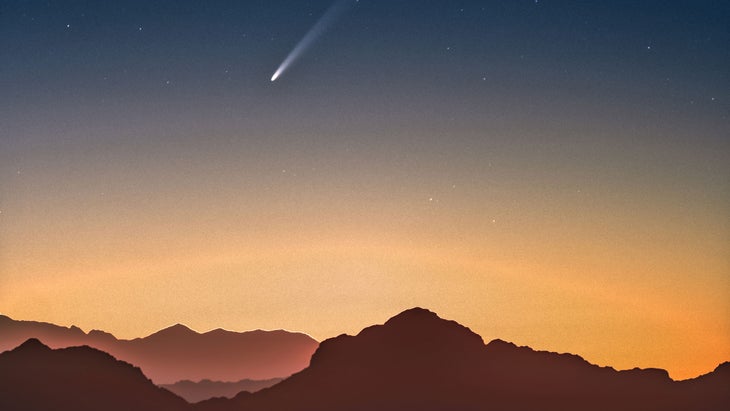
This massive heap of dust, frozen gases, and rock, which calls a “cosmic snowball,” is blasting toward earth from the edge of our solar system, and on October 11 it will reappear in the early-evening sky. It will be closest to earth—passing by our planet at a distance of some 44 million miles—on October 12. So on Saturday, look to the western horizon right after sunset to spot it. Don’t dilly-dally: because the comet’s location is so low, it will “set” about 30 minutes after the sun.
Fortunately, A3 will continue to climb in the sky throughout the month and into early November, setting around 20 minutes later each night, according to . From October 13 to 19, A3 is expected to remain brilliant, resulting in optimal viewing if clear-weather conditions hold where you are. In the days that follow, it will increasingly fade and you’ll need binoculars or a telescope to best admire it.
Comets are tough to predict—they’re light-years away, and therefore we know little about their composition, which affects brightness— so we won’t know exactly how intense A3 will be until it reappears in our sky. Optimistic astronomy buffs it could be as luminous as Jupiter. Others its radiance will be more in line with 2020’s comet Neowise, which was also visible to the naked eye and had a glow similar to the North Star. One feature to look for is its sweeping dust tail.
But even by modest predictions, signs look promising for A3 to become the comet of the year, if not decade. In fact, you likely won’t need to travel far, if at all, from a city to see it, says Hjelle. “Light pollution will play a factor, but if the brightness estimates play out, even many light-polluted areas are going to get a reasonably good view.”
Incredibly, on September 27, astronomers in Hawaii discovered that another comet, known as Comet C/2024 S1 (ATLAS), could be visible to northern-hemisphere stargazers at the end of October—and it may outshine A3 if it survives its passage by the sun. “If all goes as well as the most optimistic estimates, this comet could be visible to the naked eye during the daytime around [October] 28th,” Hjelle says. That’s big news, because only nine comets have been bright enough for daytime visibility in the past 300 years.
For now, let’s keep our sights on A3. Here’s where I suggest viewing it from the various regions of the U.S.
If you buy through our links, we may earn an affiliate commission. This supports our mission to get more people active and outside. Learn more.
The Best Places to Watch Comet A3 in Your Region
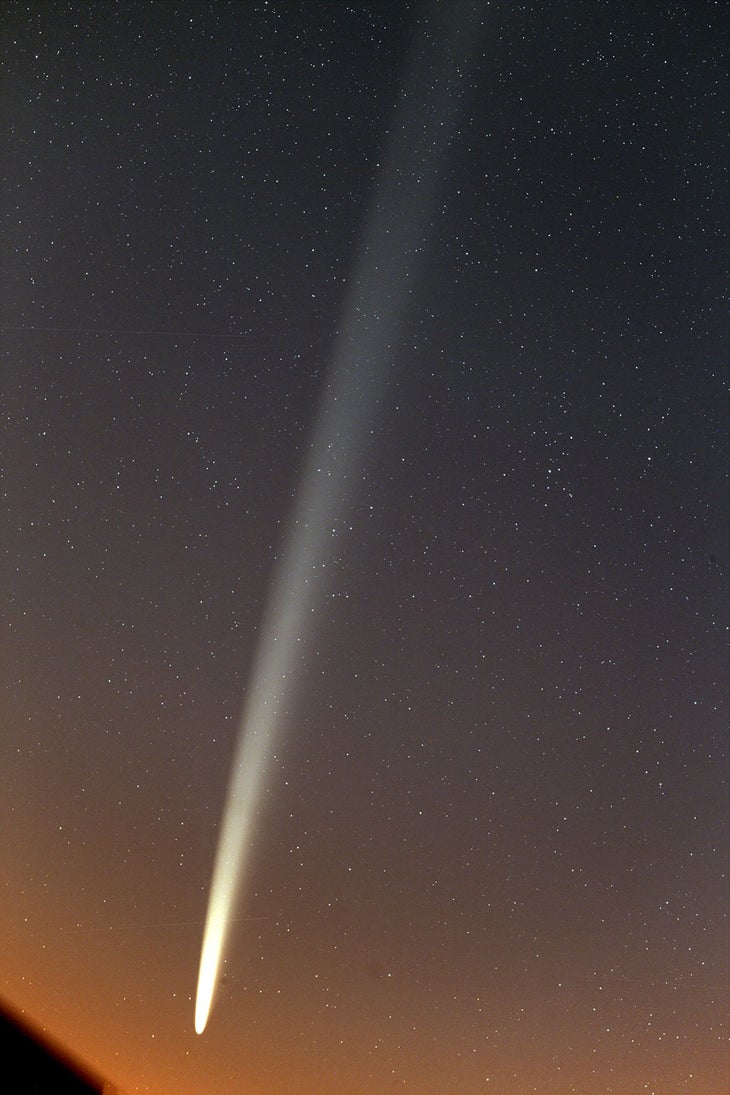
First and foremost: find a lookout with clear, unobstructed views of the western horizon, particularly during the comet’s initial streak across our sky this weekend, when A3 will be hovering just above it.
I spent hours scouting Google Earth and thinking about my favorite sunset viewpoints from my own past travels to find the most scenic, geographically dispersed, unobstructed west-facing comet A3 viewpoints in every region to ensure you don’t miss this once-in-a-lifetime show.
New England
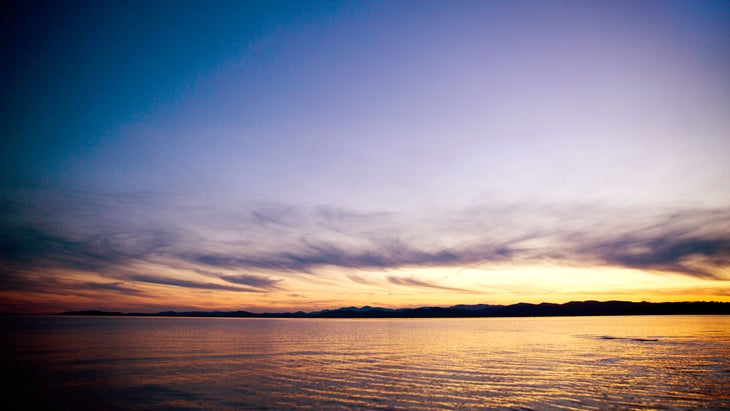
Head Here: The Colchester Causeway near Burlington, Vermont
The 2.5-mile crosses Lake Champlain to link Causeway Park (nine miles north of Burlington) to the town of South Hero. The gravel route, enjoyed via bike or on foot, offers sweeping panoramas, including near perfect west-facing views with only distant Adirondack peaks on the horizon. The farther north you head on the causeway, the better and more unobstructed the west-facing scenery. Note that the route terminates just before South Hero, and the seasonal across the water and into town is only available in the daytime, so you’ll have to head back the way you came.
Or Here: Cape Cod National Seashore in Provincetown, Massachusetts
The western stretch of , a 40-mile swath of sandy beaches, heather-dotted dunes, and quiet marshes will also offer fantastic views of the comet. Try Duck Harbor Beach in Wellfleet or Herring Cove Beach near Provincetown’s West End. Since October is outside of high season, parking and entry to most national seashore beaches is free. Even better: the national seashore’s beaches are open from 6 A.M. to midnight, which means you can catch the comet, then peer southwest into the Milky Way’s vibrant core, also best viewed in .
Mid-Atlantic
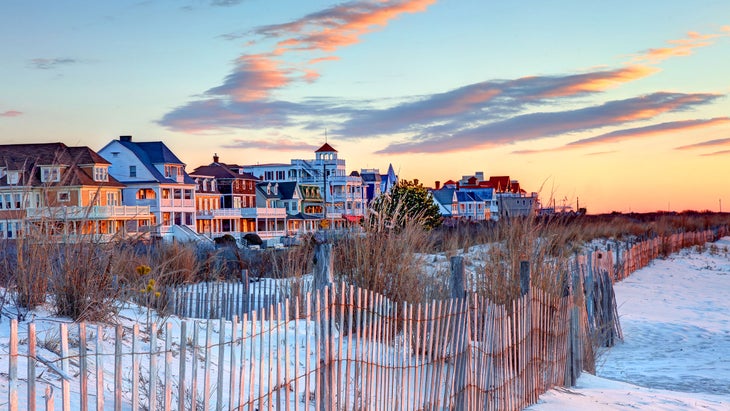
Head Here: West Cape May in Cape May, New Jersey
New Jersey’s southernmost tip allures summer shore-goers with its rainbow of colorful Victorian homes and powdery sands. This month, its western side will offer some of the region’s best comet views, too. Try Pearl Beach or Sunset Beach for unobstructed western-horizon overlooks. During the day, don’t miss the —the return of the migrating raptors—which runs through November 30. It’s best enjoyed at Hawk Watch Observation Platform. Entrance is free.
Or Here: The Edge in New York City
The majority of west-facing waterfront parks and perches in New York State close at sunset, but in city that never sleeps, sky watchers will have excellent views from on the West Side of Midtown Manhattan, especially if brightness predictions hold. Located on the 100th floor of 30 Hudson Yards, The Edge is the western hemisphere’s highest outdoor observation deck, with glass-walled 360-degree views of the metro area. It’s open daily until 9 P.M. Imagine watching A3 soar above the Hudson River and New Jersey. I suggest getting there with enough time to watch the sun set and the comet appear; since golden hour is prime visiting time, get your tickets in advance. From $40
The South
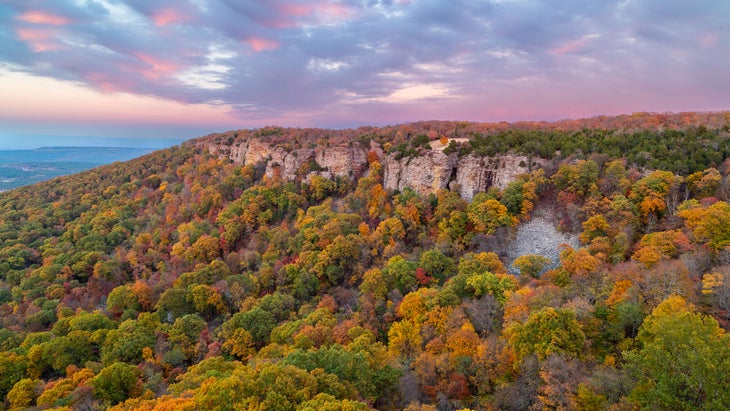
Head Here: Mount Magazine State Park in Paris, Arkansas
Western Arkansas’s is a popular rock-climbing destination. And this month, the soaring crag delivers top-notch comet watching, too. Vistas atop 2,753-foot Mount Magazine, the state’s highest point, may be obstructed by trees, but its Cameron Bluff Amphitheater offers a clear western-horizon vantage point, as do a few portions of the Cameron Bluff Recreation Area. Drive up solely for sunset and comet watching—the park closes at 10 P.M.—or make an evening of it with an early feast of Southern fare at , which overlooks the Petit Jean River Valley. It’s part of the Mount Magazine Lodge and just a mile stroll from the amphitheater (from $153). Entrance to the state park is free.
Or Here: Lake Pontchartrain in New Orleans
If you’re headed here Saturday, why not spend the entire day outdoors making the most of Lake Pontchartrain, perhaps fishing for bass and catfish (both a basic and saltwater fishing license are required) or watching for larger wildlife, such as sharks and manatees. When dusk descends, head to the 2,800-acre , which remains open to the public until 9 P.M. Or elevate your interstellar fun with a stay in the park’s lakefront cabins; the west-facing abodes reopened this fall after years of repairs following Hurricane Ida (from $150). is also available less than a mile from the waterfront (from $18). And if you’re planning on ending the day with stargazing before heading home, your best bet might be at , 28 miles south, where you can admire the cosmos until 11 P.M.
The Midwest
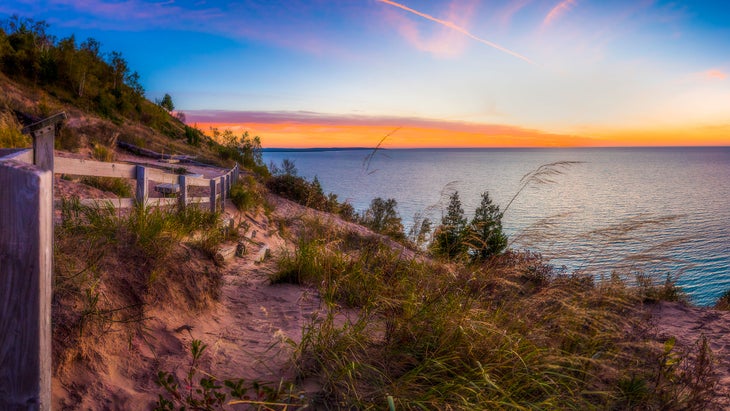
Head Here: Sleeping Bear Dunes National Lakeshore in Glen Arbor and Empire, Michigan
Unobstructed west-facing comet views abound along the world’s largest freshwater dune system, . The national lakeshore boasts 65 shorefront miles, with , dune climbs, and scenic drives—and it’s all open well past dark. (In fact, the park starlit visits.) Try the 1.5-mile round-trip for pristine Lake Michigan lookout points, or make a workout out of it with the 3.5-mile round-trip , which climbs up and over the steep sand mounds to reach another waterfront comet vista. is a more accessible option, with numerous scenic stop-offs. While the comet is the main act, keep your eyes peeled north for a glimpse of lower 48 northern lights, which could make a surprise appearance. Park entrance is $25, or use your America the Beautiful Pass.
Or Here: Badlands National Park in Wall, South Dakota
View this month’s magical space sighting from a lookout that’s equally otherworldly: Badlands National Park. A handful of its west-facing vantage points provide the chance to watch the comet above a patchwork of surreal buttes, spires, and pinnacles. Try the sweeping , where the striated rhyolite sprawls to the western horizon. Just south of that is the , where you can gaze across a patchwork of yellow and blush-tinged badlands. The park is open 24 hours. Admission starts at $15 or use your America the Beautiful Pass.
The Southwest
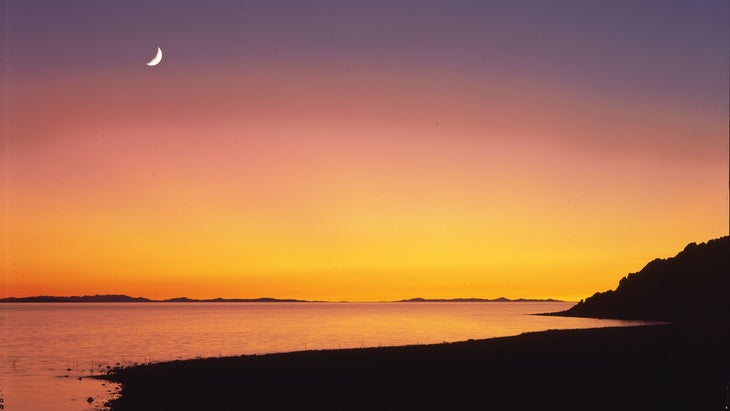
Head Here: Antelope Island State Park in Layton, Utah
wows by day with hundreds of free-ranging bison, millions of birds, and that take in the Great Salt Lake. Nighttime turns the 28,240-acre island—a DarkSky International–certified park—into a starry oasis, with a host of west-looking posts to admire the comet of the year. the half-mile out-and-back Lady Finger Point Trail for quick access to a lovely viewpoint, or meander along the largely west-facing and six-mile-roundt-rip Lakeside Trail. You can also catch A3 with the experts during the with the Ogden Astronomical Society, which begins at 6 P.M. at the White Rock Bay event area. The state park is open from 6 A.M. to 10 P.M. daily, with multiple (from $20). Admission from $15
Or Here: Monahans Sandhills State Park in Monahans, Texas
Enjoy a sea of sand dunes, and some of Texas’s least obstructed west-facing lookouts, at , not far from the Texas–New Mexico border. The park sprawls across 3,840 acres, with dunes soaring up to 70 feet and no marked trails. To see the comet, climb up a tall dune and look west as the sun paints the expanse sherbet-like shades of pink and peach—a gorgeous opening act for the luminous comet. The park remains open until 10 P.M., but given its popularity, are recommended (from $4). are available near the park entrance from $15 per night.
The West
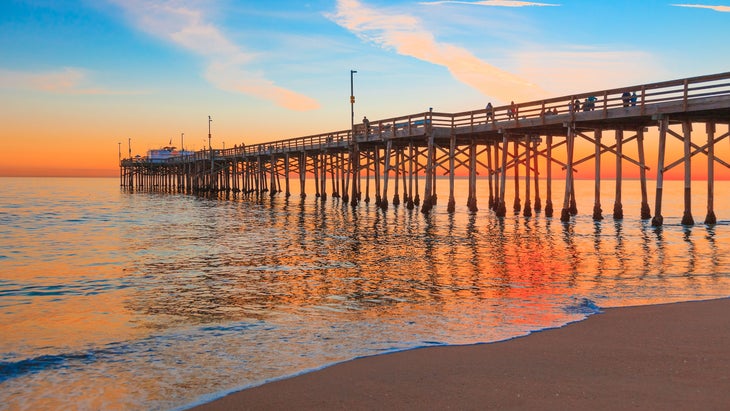
Head Here: Newport Beach, California
If you live on the Pacific coast, you’ve got the pick of the litter when it comes to west-facing views. The only issue could be the coast’s signature clouds and fog. So try sunny Newport Beach, in Orange County, which enjoys some of SoCal’s clearest skies, plus shorelines and piers that stay . The city’s namesake beach, for example, offers west-facing lookouts with a waterfront open until 10 P.M. The piers that bookend the shore, Newport Beach Pier and Balboa Pier, both look straight toward the comet and remain open until midnight. Another option is the 30-acre Corona del mar State Beach Park, which is free and open until 10 P.M.
Or Here: Lake Butte Overlook in Yellowstone National Park, Wyoming
It’s trickier to find unobstructed views for comet watching in the country’s peak-laden Mountain West—but not impossible. Try the in less-trodden eastern Yellowstone, 70 miles west of Cody. Set above the enormous Yellowstone Lake, you’ll have open views toward the direction of the comet, with the distant Teton peaks to the southwest. Yellowstone welcomes guests around the clock, and the east entrance from Cody is scheduled to remain until October 31. Admission starts at $20 or use your America the Beautiful Pass.

���ϳԹ��� and astrotourism writer Stephanie Vermillion chased 2020’s comet Neowise in Voyageurs National Park, and hopes to get another national-park sighting under her belt by catching comet A3 in Cuyahoga Valley National Park, Ohio, this month. Her upcoming book will be out December 3.


